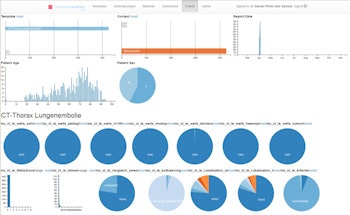
Unlike those created in the traditional free-text format, structured radiology reports enable real-time calculation of epidemiological statistics and provide significant value for decision support and quality assurance, according to German research presented at RSNA 2015 in Chicago.
After developing a Web-based reporting software engine that utilizes Integrating the Healthcare Enterprise (IHE)-compliant radiology report templates, a team from Johannes Gutenberg University of Mainz in Mainz found they could provide real-time calculation of epidemiological statistics gathered from more than 500 reports of patients being evaluated for pulmonary embolism (PE).
"The implication of the study is just to prove that structured reporting can live up to the promises it seems to make and that it can be achieved today with very simple tools in a fully IHE-compatible way," presenter Dr. Daniel Pinto dos Santos told AuntMinnieEurope.com.
Problems with free text
Still mostly the norm for radiologists, traditional free-text radiology reports are difficult to analyze by computers because they are not in a structured format. Structured reporting, however, can make it easier to extract and analyze the information contained in radiology reports, opening the door for real-time epidemiological statistics, decision support, and quality assurance, he noted.
The researchers wanted to provide a proof-of-concept for this model in a well-defined use case: evaluating for suspected PE. They sought to calculate epidemiological statistics such as incidence of PE within a set of radiology reports, mean D-dimer, and mean patient age (with or without PE) from structured reports for PE in real-time and then export the data for retrospective analysis.
As part of an effort to implement structured reporting into the institution's clinical routine, the group developed a Web-based reporting software engine that can handle IHE Management of Radiology Report Templates (MRRT)-compliant templates and acts as a report creator under the IHE MRRT profile.
"In our efforts to develop the software, we did not only translate some of the RSNA's templates, but also developed our own, mostly just because we needed German templates and wanted to adjust them to our needs and our clinical routine," dos Santos said.
The German team applied their platform to 521 consecutive cases of suspected pulmonary embolism referred from the medical emergency department. After the free-text radiology reports from these cases were converted to structured reports via an IHE MRRT-compliant template, the reports were stored in a mySQL database using the group's Web-based reporting software.
"So when a report is generated, the inputs are stored in the corresponding table, which makes it very easy to compute any sort of statistics," he explained. "Whenever a report is added to the database, these statistics are updated accordingly."
Fast epidemiological analysis
The data are easily accessible and statistics can be calculated in real-time using mySQL and the PHP open-source scripting language. The results are then displayed live on a software dashboard, enabling users to access figures such as the current incidence of PE, current number of reports, etc., according to dos Santos.
 A dashboard facilitates access to current epidemiological figures. All images courtesy of Dr. Daniel Pinto dos Santos.
A dashboard facilitates access to current epidemiological figures. All images courtesy of Dr. Daniel Pinto dos Santos."You can [also] visualize [epidemiological information] using a JavaScript library, where you can click on different subsets such as patient age," he said. "You can adjust the statistics any way you want."


Users can also view charts to delve deeper into the data.
Because the data are stored in a simple database, they can easily also be exported to Microsoft Excel or Statistical Package for the Social Science (SPSS) software for further statistical analysis, he said.
Based on their experience, the researchers concluded that structured reporting facilitates access to data collected in the clinical routine setting.
"You can easily compute epidemiological parameters in real-time and export that for future analysis," dos Santos said. "So you don't need to go back to your records and extract everything before you can do a retrospective analysis. You can just -- with two or three clicks -- choose the parameters you want and you basically have all the retrospective studies you want to do at your hands."
A demo of the group's software can be found here.
Dos Santos noted the team is in contact with the German Radiological Society (DRG) to explore the possibility of jointly developing additional structured reporting templates.



















